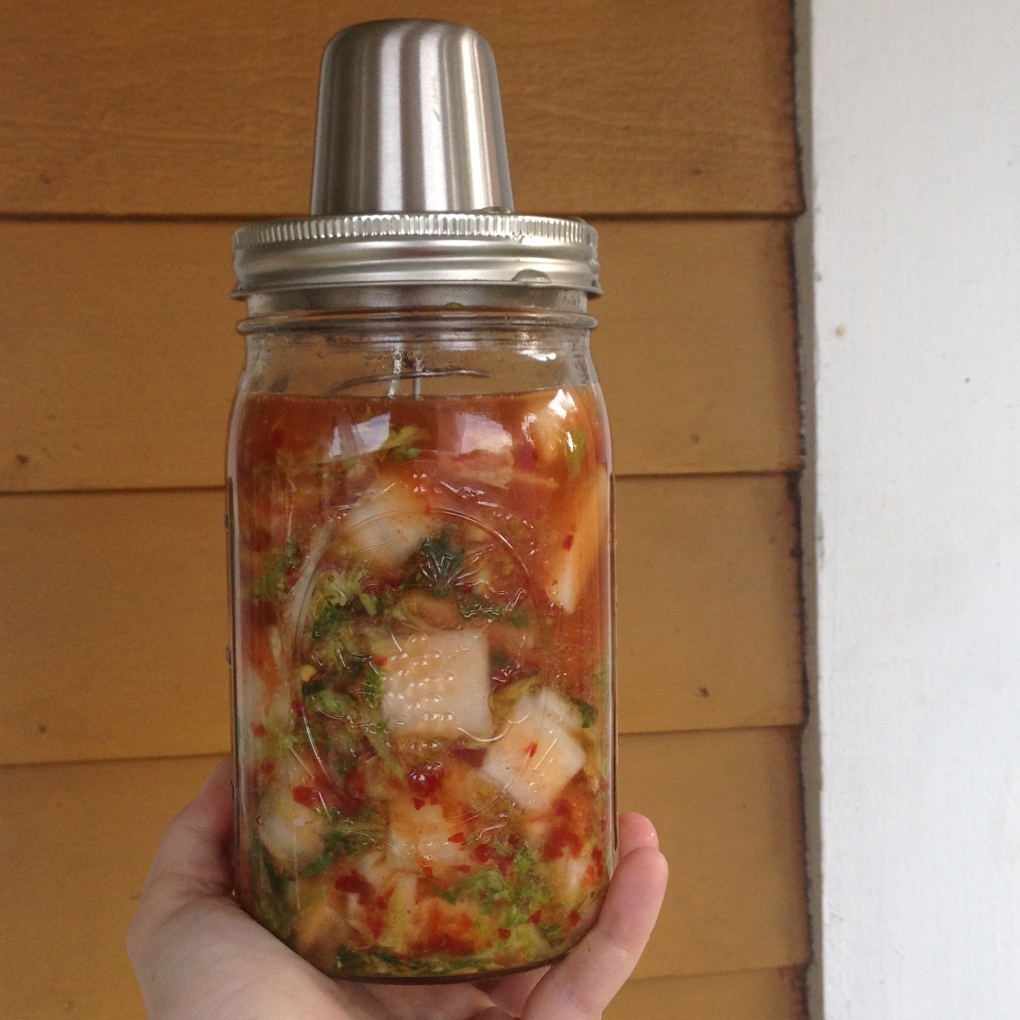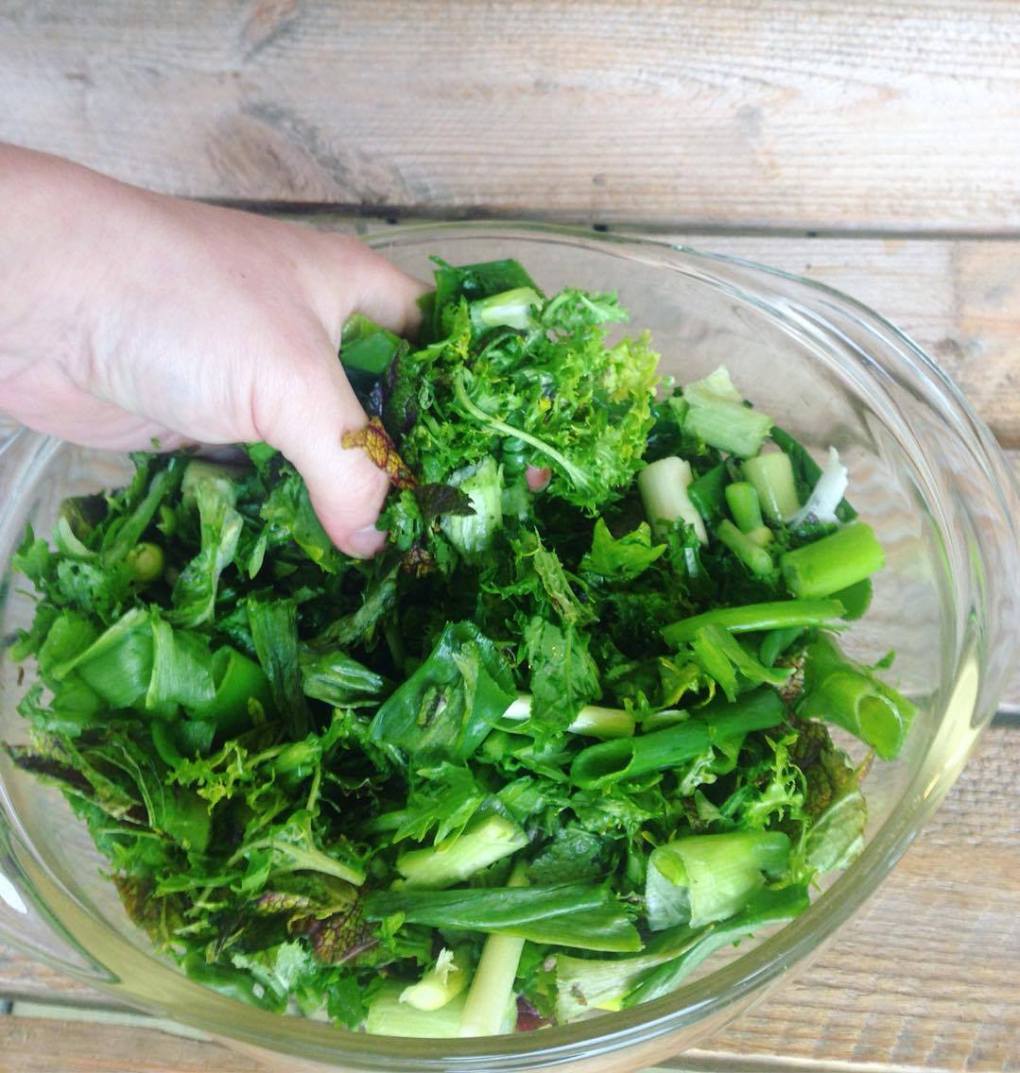The first time I tried fermented foods, I was a teenager who by chance was introduced to Sandor Katz, author of the fermentation bible Wild Fermentation. I believe we were in a park, and he had many jars of all sizes. There were samples of sauerkraut. And I was instantly hooked.
Who knew there was a salty, sour world beyond the faintly sweet bread and butter pickles that my grandmother served with her magnificent sandwich platters when I was a kid? Or the pickled jalapeños that my mom topped towers of Triscuits and cheddar cheese that we snacked on when I was in high school. Here was something better, even, than the dill spears that accompanied my sandwich at a Jewish deli in New York City.
Salty, tangy, crunchy, and flavorful, Katz’s kraut boasted all kinds of health benefits. He told us about his own experience staving off chronic illness with fermented foods. I learned the word probiotics. And I also finally understood a lesson they tried to teach me in D.A.R.E. but never understood as a kid who extremely behaved—that there are indeed gateway drugs. If kraut’s medicinal properties count, it certainly led me to funkier, more exciting fermented foods.

Sourdough, miso, kraut, pickles, yogurt, tempeh, kombucha, kefir…and, of course, kimchi. Which might be my personal favorite of all the vegetables fermented and preserved in their own brine.
This ancient dish hails from Korea, and has a history as least as old as Western civilization. One 14th century poem describes it as such:
Pickled radish slices make a good summer side-dish,
Radish preserved in salt is a winter side-dish from start to end.
The roots in the earth grow plumper everyday,
Harvesting after the frost, a slice cut by a knife tastes like a pear.
— Yi Gyubo, Dongguk isanggukjip
In other words, it’s the perfect dish to make at this time of year when spring is slip-sliding into summer. Because kimchi is such an ancient dish, and one that is the backbone of Korean cuisine, recipes come in endless varieties. There’s red, white, and many more variations. But at its essence, all you need is cabbage, radishes or turnips, garlic, spring onions, salt, and a lot of spice.
First, you’ll want a napa cabbage or two. These Chinese cabbage varieties have more tender leaves that the big green and red cabbages you’d make sauerkraut from. The napa cabbage’s leaves are almost like lettuce. It won’t be hard to wilt them by massaging a generous sprinkling of sea salt into a bowl of chopped leaves and stems.
You’ll want to cut them to bite size, whatever looks like something you’d enjoy eating. Avoid cutting too small though, like a mince or chiffon, as you want plenty of surface area to be in contact with the brine and you’ll want the veggies to stay a little crunchy. Next, rinse your cabbage leaves and give them a twirl through the salad spinner to remove excess water. Put in a glass bowl, sprinkle with salt, and let sweat for at least thirty minutes. Don’t discard the juice that comes off.
Meanwhile, matchstick the rest of your vegetables. Radishes and turnips both work great. Spring onions, with their leaves, are also lovely. You’ll also want to mince plenty of garlic. Add these to the cabbage in the bowl and let set.
Next, mix up your brine. You’ll want plenty of Korean chili flakes, Sriracha, or Sambal Olek. You might also want fish sauce or crab paste if you aren’t vegetarian or vegan—these add a salty, savory aspect that can be a really lovely compliment to the final fermented flavor. Don’t worry about using them in your brine—it’s perfectly safe, even if it feels counterintuitive to put “seafood” in something you’re going to leave on the counter for a week. These products are already processed and fermented themselves, and won’t harm your kimchi, or you.
Stir in enough of your spice—flakes, Sriracha, Sambal, etc— in to taste. Add a little water, the fish sauce or crab paste, your garlic and onions, and a little sugar. Play with the balance of flavors until you get something that you enjoy.
Once that’s done, get a clean glass or ceramic jar (if you’re using a ceramic or stoneware jar, make sure it’s food safe as some glazes can have lead or other heavy metals). A big mason jar will work nicely. Pack your cabbage/turnip/radish mixture in tightly, with the help of a rubber spatula if needed. Hopefully it will have produced enough brine that some liquid will be covering the veggies.
If not, you can put some salt into a cup of water (enough to taste like tears) and heat up until the salt is dissolved. You can add this to your spice mixture and pour over the kraut until it’s covered by at least an inch. You’ll also want to make sure you have about an inch or two of clearance from the top of the jar, to allow for expansion, bubbles, and all the other fun science that fermenting causes.

I recommend getting a
Kraut Source lid to aid in your fermentation. It’s easy to use, simple to clean, and is much less of a hassle than other methods of sealing your jar. That’s because you want to leave the kraut open to air, but not to bugs or interference. Fermentation relies on yeasts and other good bacteria naturally floating through the air. Traditionally, or if you don’t have a
Kraut Source, you’d weigh your kimchi down with a clean rock or a Ziploc baggie of water to keep it under the brine, which would let the kimchi breathe, but prevent the vegetables from contact with the air. Don’t just seal it up with a Mason jar lid yet!
Let your kimchi sit at room temperature for at least a week. Put a plate under the jar incase the brine overflows, especially if you’re using the rock or water bag method. After a week, you can taste some of the kimchi and see if you like the flavor. If you want it to get funkier, give it more time. Once you feel it’s hit peak flavor, you can put it in the fridge and enjoy for several weeks.
You might be wondering what you’ll do with kimchi once you have it on hand. After all, we’re used to thinking of fermented foods like pickles as a side dish. And kimchi can totally play that part. But it’s also delicious in soups like
kimchi jjigae, which is like the Korean version of chicken noodle soup for what ails you (I swear by jjigae for kicking a cold or any on-coming illness),
kimchi pancakes, or thrown into a stir fry, served with rice, or as a topper for miso soup or a grain bowl. You can even put it in tacos, burritos, and other non-Asian dishes for fusion flare.















